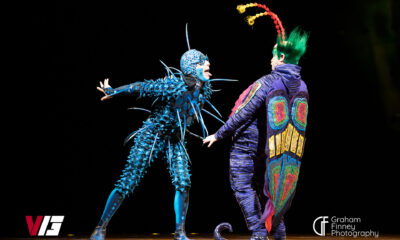Reviews
Twelve Monkeys (#096)
“100 Films for 100 Rainy Days”

Directed by: Terry Gilliam » Written by: David and Janet Peoples » Based on: La Jetée by Chris Marker, 1995 » Region/Time: USA, 129 minutes
Starring: Bruce Willis as James Cole » Madeline Stowe as Dr. Kathryn Railly » Brad Pitt as Jeffrey Goines » Christopher Plummer as Dr. Goines » David Morse as Dr. Peters.
“I find myself on another planet, Ogo, part of an intellectual elite, preparing to subjugate barbarian hordes on Pluto. But even though it’s a totally convincing reality in every way, nevertheless, Ogo is actually a construct of my psyche. I am mentally divergent in that I am escaping certain unnamed realities that plague my life here. When I stop going there, I will be well.” – TJ Washington.
As is common in so many science fiction films, there is an opening title card which begins to tell us the back-story to the world of Twelve Monkeys. Typed in green courier font, it states that 5 billion people died of a virus in 1997, that the remainder of humanity lives under ground and that animals, once again, rule the world. So far this is typical of this genre of film. However, underneath this, white lettering appears telling us these are the words of an incarcerated psychiatric patient from 1990.

In the films of director Terry Gilliam, one of the most prevalent themes is illusion vs. reality. Much as Hitchcock’s heroes frequently encounter the Wrong Man Syndrome (being accused of crimes they did not commit), so Gilliam’s heroes are frequently accused of lying or living in a false reality, when they appear to be telling the truth. Of his loose trilogy of films in the 1980s, in Time Bandits and The Adventures of Baron Munchausen the fantasies of the heroes appear to ultimately have been true in some way. In Brazil, the protagonist eventually retreats into his own fantasies to escape the miseries of the totalitarian regime he lives in.
In Twelve Monkeys, Bruce Willis plays James Cole, an unwilling time traveller from the future, sent into our present to gain samples of a virus to allow the people of the future to return to the surface. He is haunted by a recurring dream, which we see numerous times throughout the film, in which he is a child, and sees a man shot in the airport.
The “future” scenes feature outlandish costumes and sets, and wildly tilted and confusing camera angles. The 1990 and 1996 scenes, however, are more firmly rooted in reality. Initially, Cole is sent to the wrong time, 1990, and is incarcerated in a psychiatric facility where he meets patients, such as Jeffrey Goines, the son of a respected scientist, and psychiatrists, such as Dr. Railly. After the audience is shown these characters, his recurring dream is altered, and both Dr. Railly and Goines appear in the dream. Is it a dream? A memory? Or is he merely incorporating parts of his experience into his fantasies? Cole’s frequent shifts in time confuse him, and he begins to doubt his own sanity, as does the viewer. Gilliam deliberately doubles up scenes – such as the prison-style scrubbing of Cole – and characters. Not only do the dream characters appear to change, but so do characters in the real world, such as the guards, who occasionally become the guards of the “future” in Cole’s delirium.

Cole returns to the “future” and finds out that Goines may have played a key role in the release of the virus. Cole is also finding himself attracted to the psychiatrist and wishes to return to spend more time with her. When he returns to 1996, he tries to evade his superiors from the “future” and to escape with Dr. Railly to paradise. Needless to say, Fate is inescapable, and he gets drawn back into the search for The Army of the 12 Monkeys.
Twelve Monkeys is an expansion of a short, experimental French film, La Jetée, (1962) by Chris Marker, which was originally told in a series of still photographs. In both movies, there is a remarkable scene which references Alfred Hitchcock’s Vertigo. In Twelve Monkeys, James Cole and Dr. Railly hide in a cinema playing Vertigo. In the remarkably creepy scene, Kim Novak is explaining to Jimmy Stewart using a cross section of a tree trunk, when her previous incarnation was born and when she died. Later in the same movie, Jimmy Stewart’s character remakes Kim Novak to look identical to the dead woman of his fantasies. James Cole falls asleep as Dr. Railly finds some costumes to disguise them. Upon waking, he finds that he and Dr. Railly have been made up to look like the man and woman in his dream. On the soundtrack, the love theme from Vertigo plays.

This is probably Terry Gilliam’s most cohesive film and also his most grim (although I haven’t seen Tideland). However, as an ex-Monty Python member, humour is still abundant, most notably in Brad Pitt’s character, but also in Bruce Willis’ sublime performance. Gilliam was famously impressed by the scene in Die Hard in which Bruce Willis is talking to his ex-wife while pulling glass shards out of his feet. When he found out this scene was ad libbed, Bruce Willis was a virtual lock for the role of James Cole. Some viewers may choose to believe the entire time travel plot is all in Cole’s muddled head, and it certainly not inconceivable, although the movie seems to eventually come down on Cole’s side. Also worth mentioning is the fantastic score by Paul Buckmaster and marvellously warped theme tune by Astor Piazzolla which sounds like a melting circus tune.
After the financial disaster of Baron Munchausen, movie studios were leery of working with Gilliam again. However, his next two films, Fisher King and Twelve Monkeys, both came in under budget, were great financial and critical successes, and received numerous academy awards and nominations. Gilliam, however, is still considered a “difficult” director and has many stalled projects in the works that will probably never see the light of day, including Don Quixote with Johnny Depp, The Defective Detective with Bruce Willis and Neil Gaiman’s Good Omens. His latest film, The Imaginarium of Dr. Parnassus was almost deep-sixed following Heath Ledger’s death. However, filming continued with Johnny Depp, Colin Farrell and Jude Law taking over Ledger’s role for scenes “beyond the looking-glass.” I have read the screenplay and it has the potential to be the best film Gilliam has ever made. In the meanwhile, however, Twelve Monkeys remains one of the few truly great science fiction films ever made.

Up Next in the Film Canon: How To Take Responsibility for Yourself and Really Be a Man.
-

 Hardcore/Punk6 days ago
Hardcore/Punk6 days agoHastings Beat Punks Kid Kapichi Vent Their Frustrations at Leeds Beckett University [Photos]
-

 Culture7 days ago
Culture7 days agoCirque Du Soleil OVO Takes Leeds Fans on a Unique, Unforgettable Journey [Photos]
-

 Alternative/Rock5 days ago
Alternative/Rock5 days agoA Rejuvenated Dream State are ‘Still Dreaming’ as They Bounce Into Manchester YES [Photos]
-

 Music6 hours ago
Music6 hours agoReclusive Producer Stumbleine Premieres Beat-Driven New Single “Cinderhaze”
-

 Indie1 week ago
Indie1 week agoMichele Ducci Premieres Bouncy New Single “You Lay the Path by Walking on it”
-

 Culture22 hours ago
Culture22 hours agoDan Carter & George Miller Chat Foodinati Live, Heavy Metal Charities and Pre-Gig Meals
-

 Alternative/Rock1 week ago
Alternative/Rock1 week agoWilliam Edward Thompson Premieres His Stripped-Down “Sleep Test” Music Video
-

 Country1 week ago
Country1 week agoJayce Turley Reflects on “Misery” with the Premiere of His New Single




